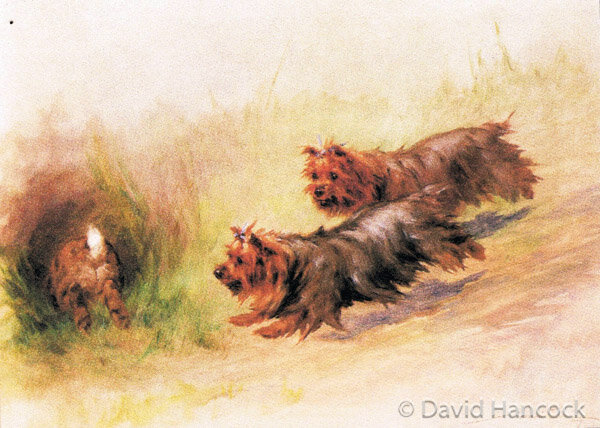1107
PUTTING A TERRIER BACK INTO YORKSHIRE
By David Hancock
The counties of England have produced some outstanding breeds of terrier, some lost, some retained and one both of those - as the smaller terrier of Yorkshire, now a Toy breed demonstrates. The two terrier breeds, by name, from that great sporting county, the Airedale and the Yorkshire itself, are now anything but terriers. The former is truly what the French would call a griffon and far to big to be an earth-dog, the latter now prized for its coat and not its sporting skills. It was not always so. Hutchinson's Dog Encyclopaedia of nearly a century ago, states: "The working men of the West Riding of Yorkshire are usually accredited with the production of this breed, now little more than half a century old, and formerly the Yorkshire Terrier was looked upon as the companion and friend of the industrial classes. The original type was a much larger dog..." The modern breed of this name could hardly get any smaller and I doubt if many working men of Yorkshire today would be happy with having to cope with a coat of this length and texture! Yorkshire has lost its sporting terrier!
If you look at the so-called Yorkshire Terrier of today, compared to the early specimens in this spirited little breed, you can see at once how exhibitors can soon ruin a sporting breed. Small black and tan working dogs have been known in Yorkshire for several centuries. The little Halifax Terrier and the Yorkshire Heeler were commonplace before the advent of breeding for ‘the pedigree’. The latter breed has been lost, unlike the neighbouring Lancashire Heeler, whilst the former is perpetuated in the Yorkshire Terrier, the tiny purely ornamental breed of that name, in the Kennel Club’s Toy group. This modern show ‘terrier’ from Yorkshire is very much a manufactured breed, materialising around 1860. In time its devotees hijacked the breed name for the ornamental exhibitors’ type of seven pound dog and in due course, the Yorkshire Terrier Club was founded in 1898. It is not historically accurate for a long-coated dwarf dog with a coat of such silky texture, so tiny physically and displayed with its topknot beribboned to be dubbed the ‘Yorkshire Terrier’. Originally, this dog was bigger and more robust, with specimens weighing from 10 to 14lbs, but 6lbs has been the weight of most of the bigger exhibits for the last century; today we see a wee scrap of a dog with a suppressed terrier spirit in a highly ornamental container.
Now I have nothing against small companion dogs that bring comfort to so many older or lonely people. I have nothing but admiration for the Yorkie; a dog of that size needs all the support it can get! I do object however to the name Yorkshire Terrier being misapplied in this way. This is not the earth-dog of that great sporting county. Its origins lie in sporting terriers, mainly those from Scotland. The links between the Clydesdale, Paisley, Skye, Dandie Dinmont and the working terriers of Yorkshire are many. The Clydesdale was a soft-coated Skye Terrier, a bright steel blue colour with a clear golden tan on the head, legs and feet. At the Islington show of 1862, Scotch terriers under six pounds were exhibited and a year later, white, fawn and blue Scotch, under seven and over seven pounds were shown. Among the blues was Platt’s Mossy, no. 3628 in the Yorkshire Terrier stud book. In 1869, the famous Huddersfield Ben made his first appearance, being placed second as a Scotch Terrier. He subsequently sired many of the ‘Toy Terriers (rough and broken-haired)’ entries and is a founder of the modern breed of Yorkie. The great sporting county of Yorkshire surrendered its breed of working earth-dog to the show ring.
The Australian Terrier illustrates how a sporting terrier breed can survive, along with its sister- and Toy breed of Australian Silky, to provide the show-ring groomers and non-sporting dog fanciers with the material they seek. The Yorkie should be renamed the Yorkshire Silky and the title of terrier removed. Then the very capable breeders of Yorkshire’s working terriers could produce a true terrier bearing their county’s name. Preferably blue and tan, 12 to 14 inches at the withers, 12 to 14lbs in weight, with a harsh close ‘pin-wire’ coat, it could be a winner! What a challenge for an artisan breeder and what a reward for a true Yorkshireman! It would also demonstrate to the show fraternity that they may have created a gap between working and ornamental dogs, but that gap can be closed and the terriermen of Yorkshire could show them how. We may have lost the Cheshire Terrier and not persevered with a Devonshire Terrier as such, but the Norfolk was revived and the Staffordshire Bull Terrier became recognised. The creation and development of the Plummer and Sporting Lucas Terrier breeds shows how dedicated terrier breeders can succeed if the will is there. A restored, genuine Yorkshire Terrier could win too - and work!









